
Leucadendron dregei, the summit conebush, is a flower-bearing shrub belonging to the genus Leucadendron and forms part of the fynbos. The plant is native to the Western Cape, South Africa.

Leucadendron rourkei, the Uniondale conebush, is a flower-bearing shrub belonging to the genus Leucadendron and forms part of the fynbos. The plant is native to the Western Cape and Eastern Cape, South Africa. The plant is rare.

Leucadendron loeriense, the Loerie conebush, is a flower-bearing shrub that belongs to the genus Leucadendron and forms part of the fynbos. The plant is native to the Western Cape, where it is found in the Elandsberg, Baviaanskloof and Groot-Winterhoek mountains. The shrub grows 2.5 m tall and flowers in December and January.
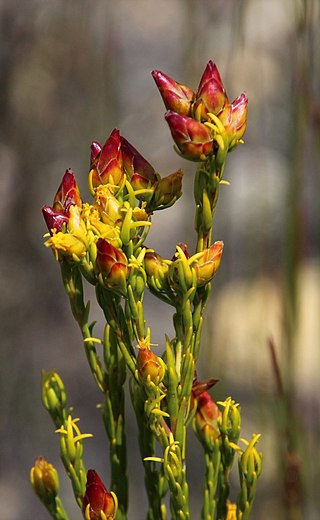
Leucadendron olens, the yellow conebush, is a flower-bearing shrub that belongs to the genus Leucadendron and forms part of the fynbos. The plant is native to the Western Cape, South Africa.
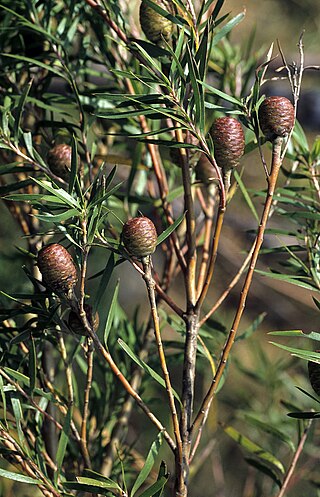
Leucadendron pondoense, the Pondoland conebush, is a flower-bearing shrub that belongs to the genus Leucadendron and forms part of the fynbos. The plant is native to the Eastern Cape where it occurs in the Pondoland from Port St. Johns to Port Edward.

Leucadendron procerum, the ivory conebush, is a flower-bearing shrub that belongs to the genus Leucadendron and forms part of the fynbos. The plant is native to the Western Cape, South Africa.

Leucadendron floridum, the flats conebush, is a flower-bearing shrub belonging to the genus Leucadendron and forms part of the fynbos. The plant is native to the Western Cape, where it occurs in the Cape Flats, from Rondebosch to Kuils River and also in the Cape Peninsula around most wetlands. The shrub grows 2 m tall and bears flowers from September to October.
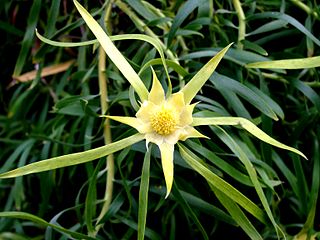
Leucadendron eucalyptifolium, the gum-leaved conebush, is a flower-bearing shrub belonging to the genus Leucadendron and forms part of the fynbos. The plant is native to the Western Cape and the Eastern Cape, where it occurs in the Potberg, Riversdal Plains, Langeberg, Outeniqua Mountains, Tsitsikamma Mountains, Kouga Mountains, Elandsberg, Swartberg, Waboomsberg, Warmwaterberg, Touwsberg, Rooiberg and Soetwaterberg. The shrub grows 4 m tall and bears flowers from July to October.

Leucadendron teretifolium, the needle-leaf conebush, is a flower-bearing shrub belonging to the genus Leucadendron and forms part of the fynbos. The plant is native to the Western Cape, South Africa.
Leucadendron thymifolium, the Malmesbury conebush, is a flower-bearing shrub belonging to the genus Leucadendron and forms part of the fynbos. The plant is native to the Western Cape, South Africa.
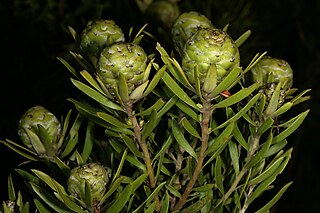
Leucadendron spissifolium subsp. oribinum, the Oribi spear-leaf conebush, is a flower-bearing shrub belonging to the genus Leucadendron and forms part of the fynbos. The plant is native to the Eastern Cape and KwaZulu-Natal where it occurs from the Oribi Plain to Mkambati.
Leucadendron osbornei, the Laingsburg conebush, is a flower-bearing shrub belonging to the genus Leucadendron and forms part of the fynbos. The plant was discovered by David Osborne and is native to the Western Cape, South Africa.
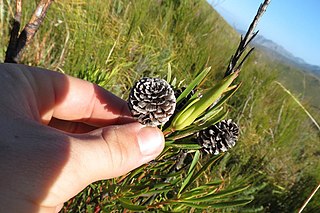
Leucadendron spissifolium subsp. phillipsii, the Kareedouwvlakte spear-leaf conebush, is a flower-bearing shrub belonging to the genus Leucadendron and forms part of the fynbos. The plant is native to the Eastern Cape and Western Cape, South Africa.

Leucadendron spissifolium subsp. spissifolium, the common spear-leaf conebush, is a flower-bearing shrub belonging to the genus Leucadendron and forms part of the fynbos. The plant is native to the Western Cape where it occurs on the Gifberg and from the Cederberg to the Cape Peninsula and Kogelberg to Kampscheberg in the Langeberg.
Leucadendron foedum, the Hopefield conebush, is a flower-bearing shrub belonging to the genus Leucadendron and forms part of the fynbos. The plant is native to the Western Cape, South Africa, and occurs from Piketberg to Hopefield.
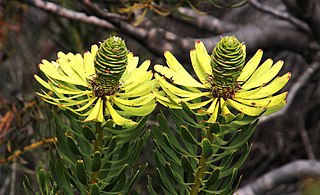
Leucadendron platyspermum, the plate-seed conebush, is a flower-bearing shrub belonging to the genus Leucadendron. It form part of the fynbos biome. The plant is native to the Western Cape, where it occurs from the Donkerhoekberg near Villiersdorp, Groenlandberg, and Kleinmondberge from Houhoek to the Elimvlakte.

Leucadendron meridianum, the limestone conebush, is a flower-bearing shrub belonging to the genus Leucadendron and forms part of the fynbos. The plant is native to the Western Cape, South Africa.
Leucadendron gydoense, the Gydo conebush, is a flower-bearing shrub that belongs to the genus Leucadendron and forms part of the fynbos. The plant is native to the Western Cape, South Africa.
Leucadendron macowanii, the acacia-leaf conebush, is a flower-bearing shrub that belongs to the genus Leucadendron and forms part of the fynbos. The plant is native to the Western Cape, South Africa.

Leucadendron levisanus, commonly known as the Cape flats conebush, is a flower-bearing shrub that belongs to the genus Leucadendron and forms part of the fynbos. The plant is native to the Western Cape, where it occurs in the Cape Flats from Vishoek to Eerste River and Mamre. The shrub grows 2 m tall and bears flowers in October.



















